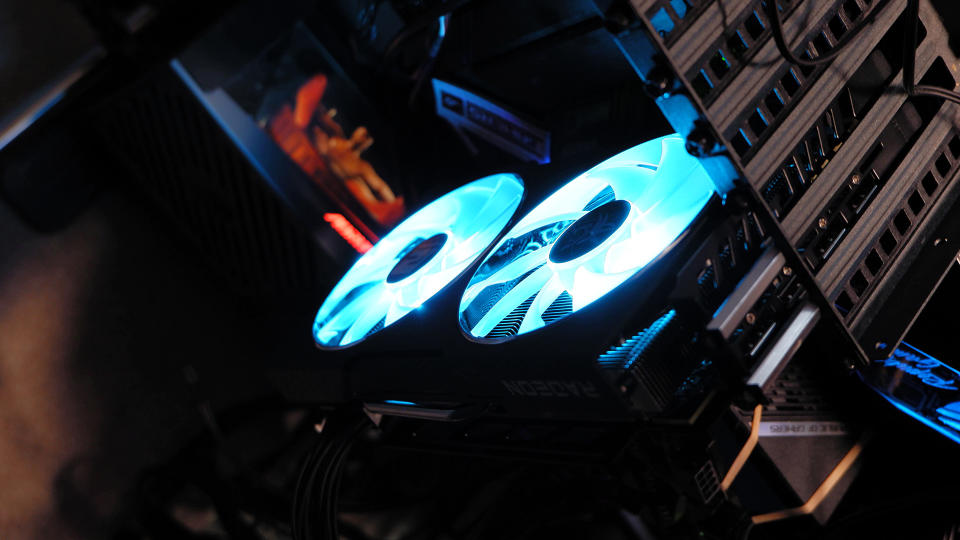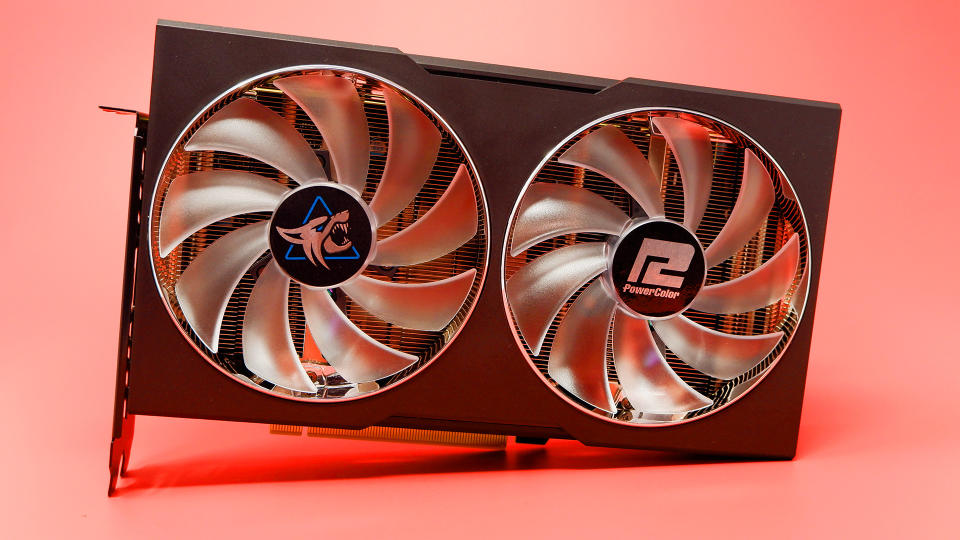How much memory your graphics card can access is critical to gaming performance, but is a larger buffer always worth spending more money on? The AMD Radeon RX 7600 XT puts this theory to the test, delivering 16 gigabytes of VRAM alongside a very well-known GPU and starting at ~$329.
The underlying core of the RX 7600 XT is almost identical to the RX 7600, which was launched in May last year. They both use the same Navi 33 GPU, with up to 2,048 shaders spread across 32 compute units (CUs). What’s unfortunate for the XT model is that the regular RX 7600 uses the full number of cores available with this chip, the full 2,048, meaning there’s no room for improvement over the XT without an entirely different GPU design. Since that doesn’t happen, we are left with an XT that looks like the non-XT almost every way.
From the identical number of shaders to the memory subsystem, the RX 7600 XT offers no surprises. There’s 32MB of Infinity Cache, which is used to limit the number of calls to the VRAM, and if the GPU needs to go further afield it does so via a 128-bit memory bus.
The XT comes with higher clock speeds than the non-XT card, even on the standard non-OC models. That said, the PowerColor Hellhound I’m looking at here is a factory OC model and runs up to a game clock of 2,539MHz and a boost clock of 2,810MHz, above the reference spec of 2,460MHz and 2,760MHz respectively.
However, it is the 16 gigabytes of GDDR6 memory that AMD hopes to attract gamblers.
That’s an abundance of VRAM compared to other graphics cards on the market at similar prices. Both the $299 (~£300) Nvidia GeForce RTX 4060 and $269 (~£250) AMD Radeon RX 7600 come with just eight gigabytes. The advantage of having more is that there’s little chance you’ll run into the limits of the onboard memory chips and have to resort to using much slower system memory far away on your motherboard – far away in cache terms anyway.
Running out of VRAM on your graphics card can be quite catastrophic for gaming performance. However, having access to larger amounts of memory won’t necessarily help you achieve higher performance in every game, only in games where 8GB of memory capacity is an issue, which is very little, as shown in the benchmarks below.
Test setup
CPU: Intel Core i9 12900K
Motherboard: Asus ROG Strix Z690-F Gaming WiFi
Storage: 2TB Sabrent Rocket 4.0 Plus
Cooler: Asus ROG Ryujin II
Power supply: Gigabyte Aorus P1200W
Memory: G.Skill Trident Z5 Neo DDR5-6000 CL30 2x 16GB
Graphics cards:
PowerColor Hellhound Radeon RX 7600XT 16GB
AMD Radeon RX 7600 (MBA)
Acer Predator BiFrost Arc A770 16GB
MSI Ventus Black 2X RTX 4060
You would generally expect some improvement at every resolution tested due to the increase in clock speed with the RX 7600 XT. That largely applies to my results. I see consistent improvements in average and minimum frame rates with the XT, although these are usually quite small. That improvement is certainly helped by the fact that I’m testing a reference RX 7600 versus a factory overclocked RX 7600 XT.
How much of that small increase in my benchmarking suite is due to increased memory demand is an entirely different question.
In the games I benchmarked that provide information on expected memory usage, Far Cry 6 and Red Dead Redemption 2, neither reaches the 8GB maximum capacity, even at 4K with the highest graphics presets enabled. That said, while RDR2 doesn’t claim to come anywhere close to using 8GB, Far Cry 6 is almost at the limit. That seems to explain why the 8GB RX 7600 falls apart at 4K in Far Cry 6, managing only a snail’s pace and easily outperforming the RX 7600 XT.


But I’m not entirely satisfied with this explanation. This is due to a thorn in AMD’s side, called Nvidia. The RTX 4060 comes with 8GB and performs almost identically to the RX 7600 XT in Far Cry 6. That goes against theory, and both Nvidia and AMD pack a lot of cache into their modern cards. That said, Nvidia’s approach with vastly increased L2 cache amounts on the RTX 40 series may suit Far Cry 6 better than AMD’s Infinity Cache and smaller L2 cache, and that somehow keeps the wolves from the door Nvidia’s brave card.
So while I have a feeling that the huge performance drop in Far Cry 6 for the RX 7600 is due to the smaller memory buffer, which the RX 7600 XT avoids by having a lot more memory available, I’m not convinced that this is the most important thing is. and not all for performance.


In most other games, the RX 7600 XT and RX 7600 perform within a few frames of each other at almost any resolution. The only other exception is Cyberpunk 2077 at 4K. Looking at the numbers you might suggest that the RX 7600 XT won’t collapse like the non-XT card under the sheer weight of Cyberpunk 2077’s ray-traced glory, although this is clutching at straws. All budget graphics cards struggle in the single digits due to the intense ray tracing used in this benchmark. It’s a bloodbath.
Increasing the resolution to 4K will often result in higher memory requirements, in rare cases even exceeding 8 GB. Although I want to be realistic here: that’s pretty much the opposite of what this affordable graphics card is intended for.


Buy as…
✅ You must have 16 GB: If you’re desperate to throw away 8GB, you might want to buy the RX 7600 XT. But don’t sleep on the Intel Arc A770 16GB either. Or the RX 6700XT!
Don’t buy if…
❌ You want the best graphics card: You could save some money and get equal or better net performance with an RTX 4060, or you could spend the same on the last-gen RX 6700 XT for more frames and still plenty of memory.
❌ 8GB won’t bother you: It may not be the perfect amount of VRAM for the future, but right now 8GB is fine for most games. For a more affordable card like this, it will probably be passable for a while.
For the most part, this RX 7600 XT is a 1080p card, and a good one at that. It normally hits over 60 frames per second in the latest games at the highest settings, and you can use AMD’s wonderful FidelityFX Super Resolution and Frame Generation to boost those numbers even further in supported titles. It’s also reasonable to expect solid 1440p performance depending on the game. But a card that is suitable for 4K is not.
I realize that the number of games that will require a larger memory capacity will only increase in the coming years. We’ve already seen The Last of Us Part 1 released with high VRAM requirements, although that’s largely due to a poor PC port rather than an intrinsic limitation of the game engine. I’m sure there will be games that will require you to dial back some graphics settings to work with 8GB cards a point in the future, but my argument today is that this card costs too much to justify a 16GB point when plugged into a fairly small GPU.
Moreover, the price of this specific model: the PowerColor Hellhound. It is a $350 card, and while it runs quietly and maintains low temperatures under load, it’s even harder to justify the higher price of the RX 7600 XT. For that money, you could consider the wildcard option: the often discounted option RX6700XT. With 12GB of memory and performance that consistently exceeds that of the RX 7600 XT, at around $340 today, it’s a solid buy while supplies last.
Personally, I’d stick with AMD’s last-gen card, or failing that, the RTX 4060, which can be found under $300, for any affordable PC build I was planning today. If you really need to have access to 16 GB on a budget, for example for some AI experiments you’re doing, an Intel Arc A770 16GB shall costs you less than AMD’s card and sometimes perform better. Intel’s Arc card bounces around more in benchmarking than AMD’s or Nvidia’s alternatives, but it’s still a solid performer and often cheap.